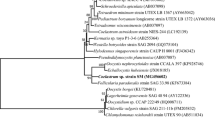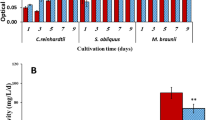Abstract
The objective of this research was to develop large-scale technologies to produce oil-rich algal biomass from wastewater. The experiments were conducted using Erlenmeyer flasks and biocoil photobioreactor. Chlamydomonas reinhardtii was grown in artificial media and wastewaters taken from three different stages of the treatment process, namely, influent, effluent, and centrate. Each of wastewaters contained different levels of nutrients. The specific growth rate of C. reinhardtii in different cultures was monitored over a period of 10 days. The biomass yield of microalgae and associated nitrogen and phosphorous removal were evaluated. Effects of CO2 and pH on the growth were also studied. The level of nutrients greatly influenced algae growth. High levels of nutrients seem to inhibit algae growth in the beginning, but provided sustained growth to a high degree. The studies have shown that the optimal pH for C. reinhardtii is in the range of 7.5. An injection of air and a moderate amount of CO2 promoted algae growth. However, too much CO2 inhibited algae growth due to a significant decrease in pH. The experimental results showed that algal dry biomass yield reached a maximum of 2.0 g L−1 day−1 in the biocoil. The oil content of microalgae of C. reinhardtii was 25.25% (w/w) in dry biomass weight. In the biocoil, 55.8 mg nitrogen and 17.4 mg phosphorus per liter per day were effectively removed from the centrate wastewater. Ferric chloride was found to be an effective flocculent that helps the algae settle for easy harvest and separation from the culture media.






Similar content being viewed by others
References
Miao, X. L., & Wu, Q. Y. (2004). High yield bio-oil production from fast pyrolysis by metabolic controlling of Chlorella protothecoides. Journal of Biotechnology, 110, 85–93. doi:10.1016/j.jbiotec.2004.01.013.
Richmond, A. (2004b). Principles for attaining maximal microalgal productivity in photobioreactors: An overview. Hydrobiologia, 512, 33–37. doi:10.1023/B:HYDR.0000020365.06145.36.
Ratledge, C., & Wynn, J. P. (2002). The biochemistry and molecular biology of lipid accumulation in oleaginous microorganisms. Applied Microbiology, 51, 1–51. doi:10.1016/S0065-2164(02)51000-5.
Vasudevan, P. T., & Briggs, M. (2008). Biodiesel production—Current state of the art and challenges. Journal of Industrial Microbiology & Biotechnology, 35, 421–430. doi:10.1007/s10295-008-0312-2.
Behzadi, S., & Farid, M. M. (2007). Review: Examining the use of different feedstock for the production of biodiesel. Journal of Chemical Engineering, 2, 480–486.
Sheehan, J., Dunahay, T., Benemann, J., & Roessler, P.(1998). A look back at the U.S. Department of Energy's Aquatic Species Program—Biodiesel from algae. A National Laboratory of the US Department of Energy, Colorado, USA.
Richmond, A. (1992). Open systems for the mass production of photoautotrophic microalgae outdoors: Physiological principles. Journal of Applied Phycology, 4, 281–286. doi:10.1007/BF02161213.
Borowitzka, M. A. (1999). Commercial production of microalgae: Ponds, tanks, tubes and fermenters. Journal of Biotechnology, 70, 313–321. doi:10.1016/S0168-1656(99)00083-8.
Cronar, N. J., & Fallowfield, H. J. (1997). Effect of nutrient loading and retention tune on performance of high rate algal ponds. Journal of Applied Phycology, 9, 301–309. doi:10.1023/A:1007917610508.
Borowitzka, M. A. (1992). Algal biotechnology products and processes matching science and economics. Journal of Applied Phycology, 4, 267–279. doi:10.1007/BF02161212.
Ginzburg, B. (1993). Liquid fuel (oil) from halophilic algae: A renewable source of nonpolluting energy. Renewable Energy, 3, 249–252. doi:10.1016/0960-1481(93)90031-B.
Gonzales, L. E., Canizares, R. O., & Baena, S. (1997). Efficiency of ammonia and phosphorus removal from a Colombian agroindustrial wastewater by the microlagae Chlorealla vulgaris and Scenedesmus dimorphus. Bioresource Technology, 60, 259–262. doi:10.1016/S0960-8524(97)00029-1.
Aslan, S., & Kapdan, I Igi Karapinar. (2006). Batch kinetics of nitrogen and phosphorus removal from synthetic wastewater by algae. Ecological Engineering, 28, 64–70. doi:10.1016/j.ecoleng.2006.04.003.
Obaja, D., Mac’e, S., & Mata-Alvarez, J. (2005). Biological nutrient removal by a sequencing batch reactor (SBR) using an internal organic carbon source in digested piggery wastewater. Bioresource Technology, 96, 7–14. doi:10.1016/j.biortech.2004.03.002.
Hoffmann, J. P. (1998). Wastewater treatment with suspended and nonsuspended algae. Journal of Phycology, 34, 757–763. doi:10.1046/j.1529-8817.1998.340757.x.
Bich, N. N., Yaziz, M. I., & Bakti, N. A. K. (1999). Combination of Chlorealla vulgaris and Eichhornia crassipes for wastewater nitrogen removal. Water Recourses, 33, 2357–2362. doi:10.1016/S0043-1354(98)00439-4.
Beardall, J., Young, E., & Roberts, S. (2001). Approaches for determining phytoplankton nutrient limitation. Aquatic Sciences, 63, 44–69. doi:10.1007/PL00001344.
Barbosa, M. J., Janssen, M., Ham, N., Tramper, J., & Wijffels, R. H. (2003). Microalgae cultivation in air-lift reactors: Modelling biomass yield and growth rate as a function of mixing frequency. Biotechnology and Bioengineering, 82, 170–179. doi:10.1002/bit.10563.
Brand, L. E., & Guillard, R. R. L. (1981). The effects of continuous light and light intensity on the reproduction rates of twenty-two species of marine phytoplankton. Journal of Experimental Marine Biology and Ecology, 50, 119–132. doi:10.1016/0022-0981(81)90045-9.
Chaumont, D. (1993). Biotechnology of algal biomass production: A review of systems for outdoor mass culture. Journal of Applied Phycology, 5, 593–604. doi:10.1007/BF02184638.
APHA,AWWA, WPCF. (1992). Standard methods for the examination of water and wastewater (18th ed.). Washington, DC: American Public Health Association.
Kates, M., & Volcani, B. E. (1966). Lipid components of diatoms. Biochimica et Biophysica Acta, 116, 264–278.
Kargi, F., & Uygur, A. (2003). Effect of carbon source on biological nutrient removal in a sequencing batch reactor. Bioresource Technology, 89, 89–93. doi:10.1016/S0960-8524(03)00031-2.
Benemann, J. (1997). CO2 mitigation with microalgae systems. Energy Conversion and Management, 38, 475–479. doi:10.1016/S0196-8904(96)00313-5.
Yang, Y., & Gao, K. (2003). Effects of CO2 concentrations on the freshwater microalgae, Chlamydomonas reinhardtii, Chlorella pyrenoidosa and Scenedesmus obliquus. Journal of Applied Phycology, 15, 1–11. doi:10.1023/A:1026021021774.
Acknowledgments
This work was partially supported by the University of Minnesota Initiative for Renewable Energy and the Environment, University of Minnesota Center for Biorefining and the Metropolitan Council Environmental Services of Minnesota.
Author information
Authors and Affiliations
Corresponding author
Rights and permissions
About this article
Cite this article
Kong, Qx., Li, L., Martinez, B. et al. Culture of Microalgae Chlamydomonas reinhardtii in Wastewater for Biomass Feedstock Production. Appl Biochem Biotechnol 160, 9–18 (2010). https://doi.org/10.1007/s12010-009-8670-4
Received:
Accepted:
Published:
Issue Date:
DOI: https://doi.org/10.1007/s12010-009-8670-4




